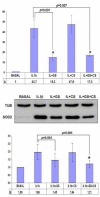Pharmacoproteomic study of the effects of chondroitin and glucosamine sulfate on human articular chondrocytes
- PMID: 20626852
- PMCID: PMC2945029
- DOI: 10.1186/ar3077
Pharmacoproteomic study of the effects of chondroitin and glucosamine sulfate on human articular chondrocytes
Abstract
Introduction: Chondroitin sulfate (CS) and glucosamine sulfate (GS) are symptomatic slow-acting drugs for osteoarthritis (OA) widely used in clinic. Despite their widespread use, knowledge of the specific molecular mechanisms of their action is limited. The aim of this work is to explore the utility of a pharmacoproteomic approach for the identification of specific molecules involved in the pharmacological effect of GS and CS.
Methods: Chondrocytes obtained from three healthy donors were treated with GS 10 mM and/or CS 200 μg/mL, and then stimulated with interleukin-1β (IL-1β) 10 ng/mL. Whole cell proteins were isolated 24 hours later and resolved by two-dimensional electrophoresis. The gels were stained with SYPRORuby. Modulated proteins were identified by matrix-assisted laser desorption/ionization time-of-flight (MALDI-TOF/TOF) mass spectrometry. Real-time PCR and Western blot analyses were performed to validate our results.
Results: A total of 31 different proteins were altered by GS or/and CS treatment when compared to control. Regarding their predicted biological function, 35% of the proteins modulated by GS are involved in signal transduction pathways, 15% in redox and stress response, and 25% in protein synthesis and folding processes. Interestingly, CS affects mainly energy production (31%) and metabolic pathways (13%), decreasing the expression levels of ten proteins. The chaperone GRP78 was found to be remarkably increased by GS alone and in combination with CS, a fact that unveils a putative mechanism for the reported anti-inflammatory effect of GS in OA. On the other hand, the antioxidant enzyme superoxide dismutase 2 (SOD2) was significantly decreased by both drugs and synergistically by their combination, thus suggesting a drug-induced decrease of the oxidative stress caused by IL-1β in chondrocytes.
Conclusions: CS and GS differentially modulate the proteomic profile of human chondrocytes. This pharmacoproteomic approach unravels the complex intracellular mechanisms that are modulated by these drugs on IL1β-stimulated human articular chondrocytes.
Figures






References
-
- Reginster JY, Deroisy R, Rovati LC, Lee RL, Lejeune E, Bruyere O, Giacovelli G, Henrotin Y, Dacre JE, Gossett C. Long-term effects of glucosamine sulphate on osteoarthritis progression: a randomised, placebo-controlled clinical trial. Lancet. 2001;357:251–256. doi: 10.1016/S0140-6736(00)03610-2. - DOI - PubMed
-
- Leeb BF, Schweitzer H, Montag K, Smolen JS. A metaanalysis of chondroitin sulfate in the treatment of osteoarthritis. J Rheumatol. 2000;27:205–211. - PubMed
Publication types
MeSH terms
Substances
LinkOut - more resources
Full Text Sources
Other Literature Sources
Miscellaneous

